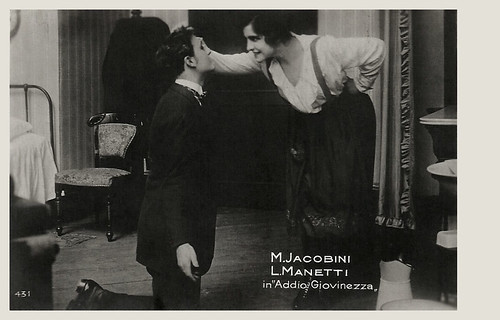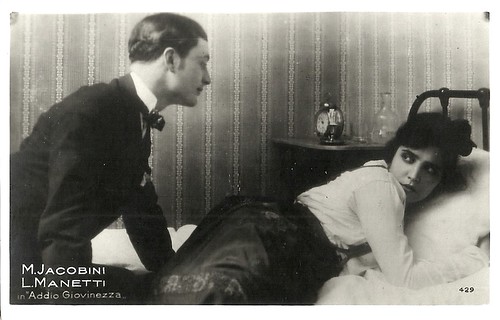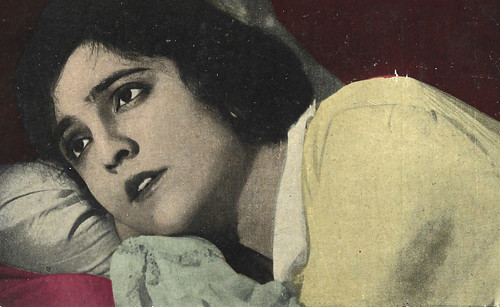
Italian postcard by Ed. G. Vettori, Bologna, no. 142. Photo: Itala Film. Lido Manetti, Ruggero Capodaglio and Maria Jacobini in Addio giovinezza!/Goodbye Youth! (Augusto Genina, 1918).

Italian postcard by Ed. G. Vettori, Bologna, no. 430. Photo: Itala Film. Maria Jacobini and Lido Manetti in Addio giovinezza!/Goodbye Youth! (Augusto Genina, 1918).

Italian postcard by Ed. G. Vettori, Bologna, no. 431. Photo: Itala Film. Maria Jacobini and Lido Manetti in Addio giovinezza!/Goodbye Youth! (Augusto Genina, 1918).

Italian postcard by Ed. G. Vettori, Bologna, no. 429. Photo: Itala Film. Maria Jacobini and Lido Manetti in Addio giovinezza!/Goodbye Youth! (Augusto Genina, 1918).

Italian postcard by Ed. G. Vettori, Bologna, no. 1048. Photo: Itala Film. Maria Jacobini in Addio giovinezza!/Goodbye Youth! (Augusto Genina, 1918).
Maria Jacobini's tribute to her killed boyfriend
Addio giovinezza!/Goodbye Youth (1918) was adapted from the 1911 play of the same name by Nino Oxilia and Sandro Camasio. The play had already been adapted to film in 1913 for Itala Film and directed by Camasio and would be adapted (directed again by Genina) in 1927, while a sound version was done in 1940 by Ferdinando Maria Poggioli. Giuseppe Pietri also turned the same play into a popular stage operetta in 1915.
Augusto Genina was also responsible for the script. Addio giovinezza!/Goodbye Youth is set in Turin at the beginning of the twentieth century. Mario, a student (Lido Manetti), begins a romance with a seamstress, Dorina (Maria Jacobini), the daughter of his landlady. However, he is lured away by a sophisticated older woman (Helena Makowska) to Dorina's distress. With the help of Leone, Mario's friend, Dorina manages to have a talk with Elena, convincing her to give up the boy.
Elena, the lady, is willing to give up Mario after hearing the pleas of Dorina, but Mario, arriving too late, becomes angry with Dorina and leaves her. After many comical and dramatic scenes, misunderstandings, love and quarrels, Mario and Dorina say goodbye after his graduation before he returns to his natal town.
Addio giovinezza!/Goodbye Youth (1918) was produced by Itala Film of Turin. Shooting of the film started a few months after the death of Nino Oxilia. Oxilia, who should have directed the film, fell in battle at the age of twenty-eight on Mount Tomba on 18 November 1917 and was substituted by Genina. Maria Jacobini, who had been Oxilia's girlfriend, was the star of the film. The work was heralded in the press as a tribute to Oxilia by the diva and their friend, director Augusto Genina.
On its release (6 December 1918), in a very difficult historical period (the war had just ended), Addio giovinezza!/Goodbye Youth! was not as successful as hoped. While in Europe all prints and even the camera negative of Addio giovinezza were lost, a copy found its way, most likely in the 1920s, into the collection of Tomjiro Komiya, a restaurateur in Tokyo and a great fan of European cinema from the 1910s. After being restored by the Cineteca di Bologna in collaboration with the Museo Nazionale del Cinema in Turin and the National Film Center in Tokyo, it was presented in 2014 at the Festival del Cinema Ritrovato in Bologna.

Spanish cromo (collector card) by Chocolate Imperiale, card 1 of 6. Photo: Distr. J. Verdaguer, Barcelona / Itala Film. Maria Jacobini in Addio giovinezza!/Goodbye Youth! (Augusto Genina, 1918). The Spanish release title was Adios, juventud!

Spanish collector card by Chocolate Imperiale, card 2 of 6. Photo: J. Verdaguer, Barcelona / Itala Film. Helena Makowska and Lido Manetti in Addio giovinezza/Goodbye Youth! (Augusto Genina, 1918).

Spanish collector card by Chocolate Imperiale, card 3 of 6. Photo: Distr. J. Verdaguer, Barcelona / Itala Film. Maria Jacobini and Lido Manetti in Addio giovinezza!/Goodbye Youth! (Augusto Genina, 1918).

Spanish collector card by Chocolate Imperiale, card 4 of 6. Photo: Distr. J. Verdaguer, Barcelona / Itala Film. Maria Jacobini and Helena Makowska in Addio giovinezza!/Goodbye Youth! (Augusto Genina, 1918).

Spanish collector card by Chocolate Imperiale, card 5 of 6. Photo: Distr. J. Verdaguer, Barcelona. Maria Jacobini and Helena Makowska in Addio giovinezza!/Goodbye Youth! (Augusto Genina, 1918).

Spanish collector card by Chocolate Imperiale, card 6 of 6. Photo: J. Verdaguer, Barcelona / Itala Film. Maria Jacobini in Addio giovinezza/Goodbye Youth! (Augusto Genina, 1918).
Another discovery
The rediscovery of Addio giovinezza!/Goodbye Youth! (1918) led to a further discovery: Claudia Gianetto, then head of the film archive of the Museo Nazionale del Cinema in Turin, recognised Segundo de Chomón in a shot together with Jacobini at minute 01:08:06:23 of Addio giovinezza!. This would be the only film fragment in which the famous film pioneer and special effects master of the silent classic Cabiria (Giovanni Pastrone, 1914) is immortalised.
In 2016, a study on Addio giovinezza!/Goodbye Youth! (1918) was published in which author Patrizia Deabate pointed out how director Augusto Genina had realised a kind of wartime actualisation of the story, inserting an implicit parallelism between the farewell to love of the seamstress Dorina and the real one of Maria Jacobini, who had tragically lost her partner.
Indeed, at the time of its first release, G. Lega already wrote in the journal La Cine-Fono: "Today with the beautiful, pure face of Maria Jacobini you [Dorina] have returned for us. And this singular actress, first among the first, was able to give you all her faith as a woman, all her aristocratic finesse as a performer. [...]
We have lost many things with you, Dorina; and also many very precious things. Behind the flowering gardens of our dying hopes open boundless cemeteries and our surviving youth has gone away with you. [...] And, almost, today one can no longer weep over memories because the strong people - the ones in charge - say it is cowardice. Everything, you know, Dorina, everything today is forbidden to us. Even loving. Mario was much happier than us, even in his tremendous pain; and his 'goodbye' is for us, now."
In 2020 Addio giovinezza!/Goodbye Youth! (1918) was included in a DVD box with four films by Augusto Genina, released by Il Cinema Ritrovato, which also includes the 1927 version starring Carmen Boni. The box, 'Augusto Genina. Il prezzo della bellezza/The Price of Beauty', curated by Mariann Lewinsky and Andrea Meneghelli, also contains La maschera e il volto (1919), with Italia Almirante Manzini, and Prix de beauté (1930), with Louise Brooks.

Spanish postcard by Leonar. Union universal de correos. Photo: Itala Film. Maria Jacobini in Addio giovinezza!/Goodbye Youth! (Augusto Genina, 1918).

Italian postcard by Ed. G.B. Falci, Milano, no. 698. Photo: Films Genina. Carmen Boni in Addio giovinezza/Goodbye Youth! (Augusto Genina, 1927).

Romanian postcard. Clara Calamai as the rich seductress Elena in Addio, giovinezza!/Goodbye Youth! (Ferdinando Maria Poggioli, 1940).
Sources: Gian Luca Farinelli and Claudia Gianetto (Il Cinema Ritrovato), Wikipedia (Italian and English) and IMDb.
No comments:
Post a Comment